Closer Look: Permafrost
Austin, Texas
April 19, 2019
Photo of the Day:
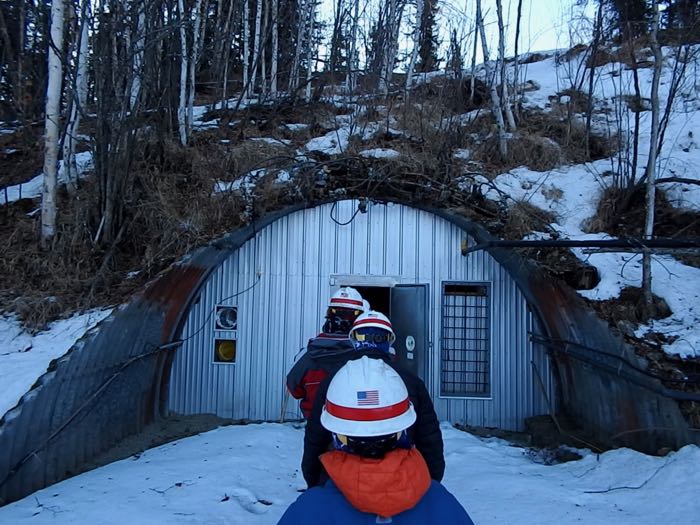 The 2019 PolarTREC cohort enters the CRREL Permafrost Tunnel Research Facility in Fairbanks, AK.
The 2019 PolarTREC cohort enters the CRREL Permafrost Tunnel Research Facility in Fairbanks, AK.
A central focus of the work I'll be assisting with in June concerns permafrost. What is this stuff, anyway? In consulting a variety of resources over the past week, I realized I had a lot to learn.
Permafrost actually has quite the formal definition - it's ground (soil, rock, or sediment) that remains at or below freezing for a minimum of two years.12 This might seem difficult to achieve, but evidence suggests otherwise. In the Northern Hemisphere, I was startled to learn that 24% of all land is permafrost.3 In northern Alaska, where I'll be this summer, alpine permafrost covers an area of roughly 263 square kilometers.4
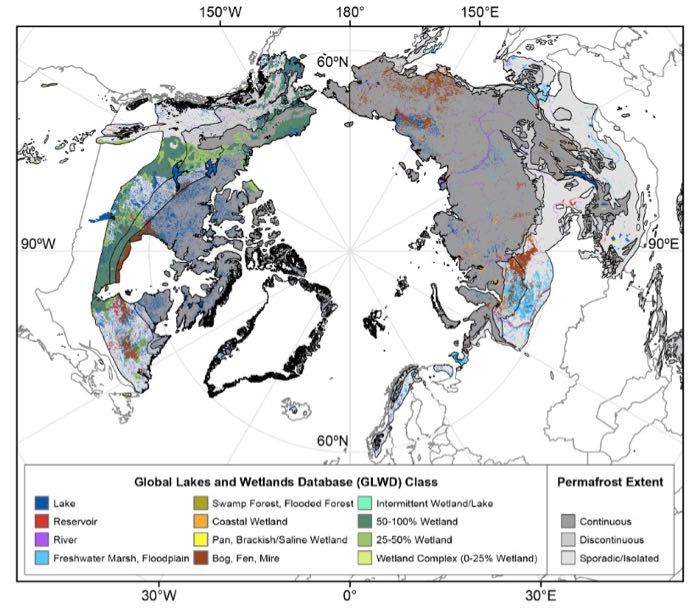 The geographic range of permafrost in the Northern Hemisphere. Source: Vonk, et al., 2015.
The geographic range of permafrost in the Northern Hemisphere. Source: Vonk, et al., 2015.
Permafrost has an interesting anatomy. Although it can get up to 1500 meters deep in certain areas, its thickness is more commonly on the order of several hundred meters. Above a deposit of permafrost, there typically exists an "active layer" of a couple meters, defined as active because it periodically freezes and thaws with the seasons.15
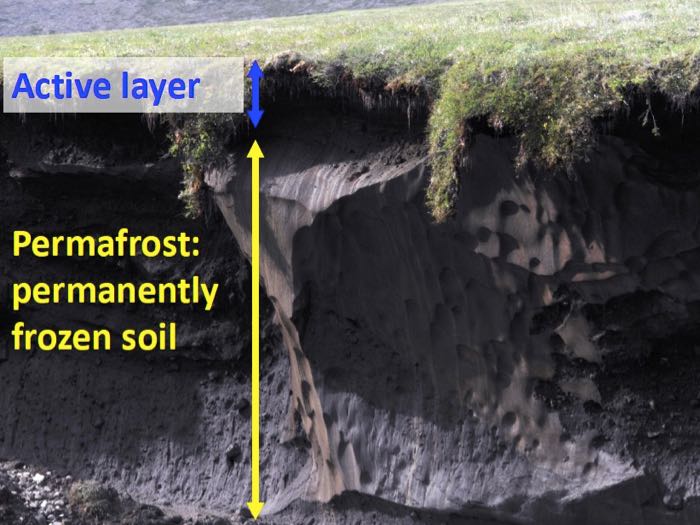 A thin "active layer" is visible above the permafrost near Toolik Research Station in the Alaskan Arctic. Source: Dr. Rose Cory (University of MIchigan).
A thin "active layer" is visible above the permafrost near Toolik Research Station in the Alaskan Arctic. Source: Dr. Rose Cory (University of MIchigan).
Permafrost notably houses, frozen within it, a staggeringly large amount of organic material. A relatively recent study suggests that over 1600 billion tons of carbon is locked up in permafrost, this being over double the amount of carbon in the atmosphere.3 The organic material in permafrost is often quite old. During our tour of the CRREL Permafrost Tunnel Research Facility near Fairbanks, we observed evidence in the permafrost of willow shrubs, birch, and alder trees that lived over 10,000 years ago!6
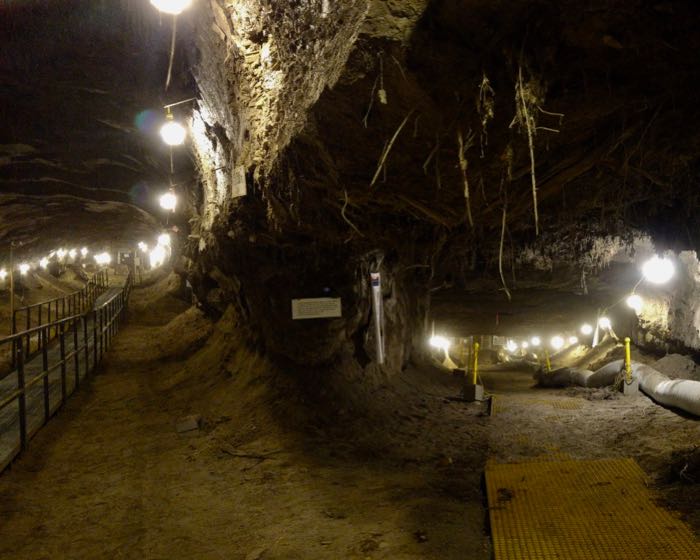 Evidence of Pleistocene plants in the ceiling of the CRREL Permafrost Tunnel Research Facility. Fairbanks, Alaska.
Evidence of Pleistocene plants in the ceiling of the CRREL Permafrost Tunnel Research Facility. Fairbanks, Alaska.
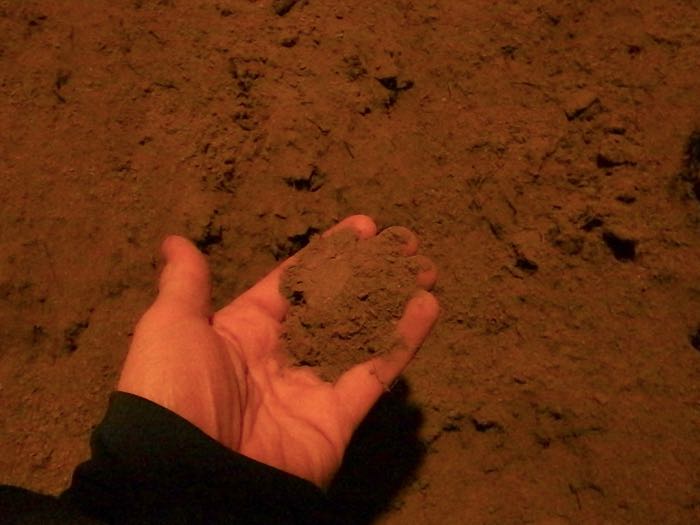 The dusty silt ever-present in the CRREL Permafrost Tunnel Research Facility contains a great deal of organic material.
The dusty silt ever-present in the CRREL Permafrost Tunnel Research Facility contains a great deal of organic material.
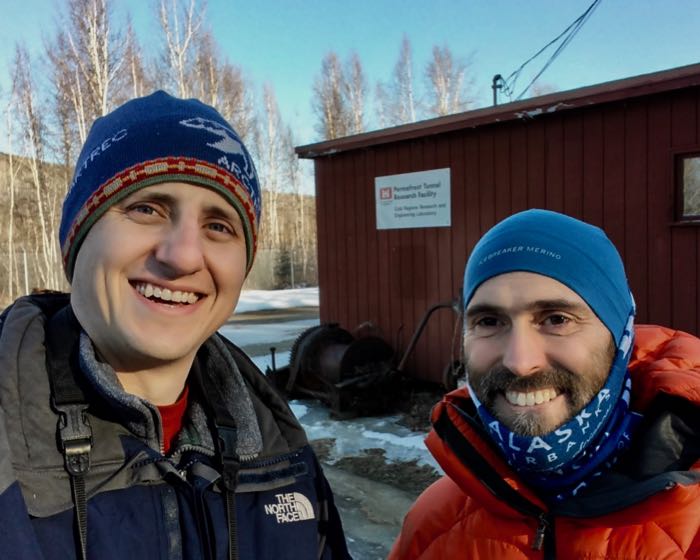 Dr. Pat Druckenmiller gave us a wonderful tour of the CRREL Permafrost Tunnel Research Facility during PolarTREC orientation week in Fairbanks.
Dr. Pat Druckenmiller gave us a wonderful tour of the CRREL Permafrost Tunnel Research Facility during PolarTREC orientation week in Fairbanks.
Permafrost also incorporates a variety of ice formations within its matrix. Commonly present are ice wedges, which grow over time in permafrost due to freeze-thaw cycles. During the winter, cracks form in the permafrost, which are filled during the spring/summer with melt water. This melt water then freezes during the subsequent winter. This cycle repeats each year, resulting in the development of a wedge formation within the permafrost.6
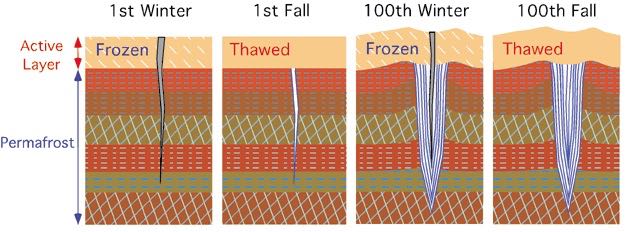 Diagram illustrating the formation of an ice wedge in permafrost over time. Source: Pidwirny, 2006.
Diagram illustrating the formation of an ice wedge in permafrost over time. Source: Pidwirny, 2006.
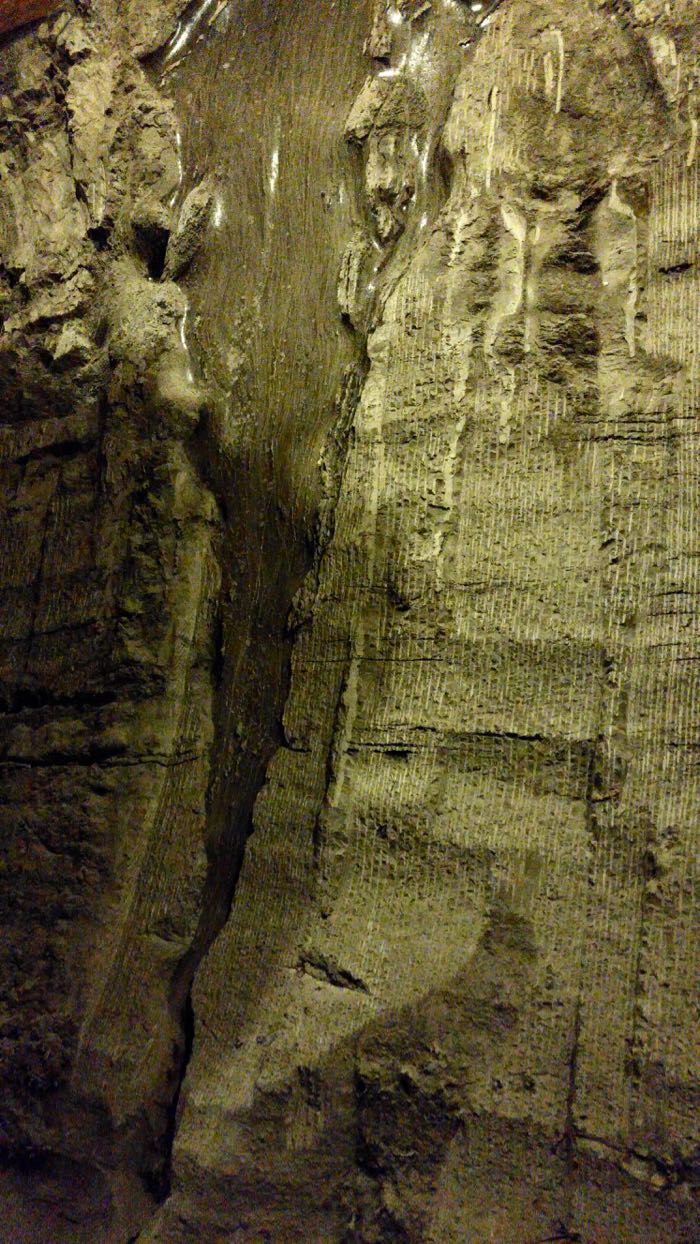 An ice wedge in the wall of the CRREL Permafrost Tunnel Research Facility. Fairbanks, Alaska.
An ice wedge in the wall of the CRREL Permafrost Tunnel Research Facility. Fairbanks, Alaska.
Freeze-thaw cycles in the active layer above permafrost often yield very interesting networks of above-ground features (called "patterned ground").6 For example, networks of ice wedges in permafrost can look from above like connected polygons. I can't imagine what initial explorers of these areas thought of these strange formations.
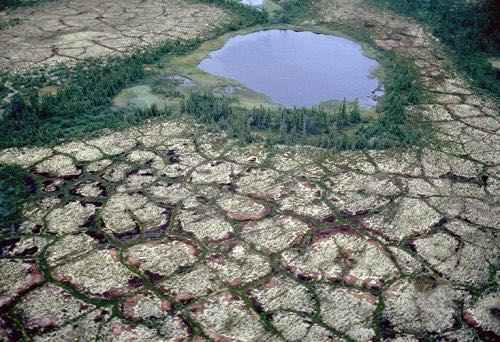 Ice wedge polygons are readily visible in the peatland of the Hudson Bay Lowlands, Manitoba. Image Source: Natural Resources Canada, Terrain Sciences Division, Canadian Landscapes.
Ice wedge polygons are readily visible in the peatland of the Hudson Bay Lowlands, Manitoba. Image Source: Natural Resources Canada, Terrain Sciences Division, Canadian Landscapes.
Arctic Fact of the Day:
In 2012, a team from Russia managed to resurrect a plant whose seeds had been frozen in Siberian permafrost for over 30,000 years!7 They found the seeds in fruit tissue discovered in a fossilized burrow of an Ice Age squirrel. Here's the whole story.
Arctic Question of the Day:
Many of my future posts will address the environmental and geobiological problems associated with increased thawing of permafrost, brought on by climate change. What are some of these problems?
(Comment below!)
-
Taterka, Bruce and Rose Cory. “Thawing Permafrost Lessons and Lab Manual: A Multi-Lesson Resource.” PolarTREC, 20 Sept. 2015, www.polartrec.com/resources/lesson/thawing-permafrost-lessons-and-lab-manual-a-multi-lesson-resource. ↩︎ ↩︎
-
Vonk, J. E., et al. “Reviews and Syntheses: Effects of Permafrost Thaw on Arctic Aquatic Ecosystems.” Biogeosciences Discussions, vol. 12, no. 13, 10 July 2015, pp. 10719–10815, ↩︎
-
Tarnocai, C., et al. “Soil Organic Carbon Pools in the Northern Circumpolar Permafrost Region.” Global Biogeochemical Cycles, vol. 23, no. 2, June 2009. ↩︎ ↩︎
-
Bockheim, James G., and Jeffrey S. Munroe. “Organic Carbon Pools and Genesis of Alpine Soils with Permafrost: A Review.” Arctic, Antarctic, and Alpine Research, vol. 46, no. 4, Nov. 2014, pp. 987–1006. ↩︎
-
Pidwirny, M. (2006). "Periglacial Processes and Landforms". Fundamentals of Physical Geography, 2nd Edition. ↩︎
-
US Army Corps of Engineers. Permafrost Tunnel Research Facility, U.S. Army Engineer Research and Development Center (ERDC), 2019, www.erdc.usace.army.mil/CRREL/Permafrost-Tunnel-Research-Facility. ↩︎ ↩︎ ↩︎
-
Yashina, S., et al. “Regeneration of Whole Fertile Plants from 30,000-y-Old Fruit Tissue Buried in Siberian Permafrost.” Proceedings of the National Academy of Sciences, vol. 109, no. 10, 21 Feb. 2012, pp. 4008–4013 ↩︎


Comments
Add new comment